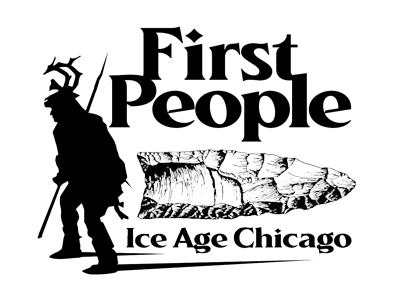Glaciers, Lakes & Landscapes


Chicago at the end of the last Ice Age
Ice Age Chicago was a dynamic, recently deglaciated landscape at the end of the Pleistocene. As the landscape evolved, people would have had to adapt to rapid climate change, shifting plant and animal communities, isostatic rebound following the retreat of continental ice sheets, and rising and falling water levels in Lake Michigan that opened up (or submerged) large areas around modern day Chicago. Modern day Cook County is a landform created during the end of the last geologic era. Born out of torrents of glacial water and ice, Cook County contains glacial moraines, ancient lake shorelines and ancient river valleys which measure over a mile wide. Landscapes that were carved by ice and the waves of ancient Glacial Lakes now carry the commercial traffic and water flow of a modern metropolitan area.
But when human foraging groups first entered the region 13,000 years ago, they would have seen a relatively open spruce parkland with no modern analog. Modern boreal forests in Canada are perhaps the closest equivalent, but the spruce forests surrounding the southern end of Lake Michigan at the end of the Ice Age would have been more open and included an odd mix of other trees like fir and ash that do not grow together today. Over the next several thousand years as climates warmed and modern plant and animal communities were established, this spruce forest would have eventually been replaced by deciduous forests with oak, ash, and elm – first in central Illinois, and later to the north.

Northeast Illinois and Wisconsin are also punctuated by numerous small lakes, wetlands, and marshes that formed during this period behind recessional moraines or in glacial kettle holes. These would have been productive habitats, and likely would have been a major draw for human foragers – and the prey they depended on like caribou or waterfowl.
Sculpting Ice Age Chicago
Nearly all of northern Illinois and Wisconsin (aside from the unglaciated Driftless Area) was blanketed by glacial ice at some point during the Wisconsinan (35-11 kya) or earlier Illinoian (300-130 kya) and pre-Illinoian (>780 kya) glaciations. During the peak of the last Ice Age (the Last Glacial Maximum or LGM) the Laurentide ice sheet reached its maximum extent in the Lake Michigan and Lake Superior basins at 30-26,000 years ago and began a fitful series of retreats and minor readvances after 17,000 years ago. Glacial retreat in the Lake Michigan basin exposed areas that had been covered by glacial ice for millennia, paving the way for the northward expansion of plant and animal communities which had persisted in southern refugia throughout much of the Pleistocene.
In general, late Ice Age climates were cold and dry. Just after people first arrived in the region, the Younger Dryas cold snap (12,900-11,600 years ago) reversed the trend toward warmer temperatures – glaciers readvanced, spruce forests expanded, and temperatures may have dropped by as much as 7° Fahrenheit. What effect this had on human groups in the area is harder to say, but archaeological evidence suggests the Younger Dryas stalled the colonization process for several thousand years in places like northern Wisconsin.


Changes in Lake Michigan water levels over the last 14,000 years have also had a dramatic effect on the landscape around Cook County. Lake levels in glacial Lake Chicago (the precursor to Lake Michigan) were substantially higher than today, drowning large parts of the landscape in Cook and Will Counties and adjacent parts of northeast Indiana. We can still see the evidence of this today in relict beach ridges and sand dunes in the area. Given the high water levels, we should not expect to find the earliest (Clovis) sites in some parts of Cook County, with the exception of areas that would have been above the water level on spits or islands.
After 11,500 years ago though, lake levels dropped dramatically, falling by more than 70 m and shifting the shoreline by as much as 30 miles. This opened up huge areas of former lake bottom for human habitation in areas that likely would have become productive marshland. Rising lake levels eventually submerged these areas once again, and Lake Michigan reached its modern level by about 4,000 years ago. Geologic evidence tells us that this rise in lake levels would have been very rapid – fast enough that changes would have been visible during a person’s lifetime. We even have sunken forests that are preserved on the bottom of Lake Michigan.
Could archaeological sites be preserved underwater in Lake Michigan too? The fact that lake levels rose so quickly means that beach formation and associated erosion would have been minimal. We can also see submerged paleochannels that formed when rivers ran miles and miles further to the east. Human groups likely followed them as well, and the possibility of early sites on the lake bottom is certainly intriguing.

